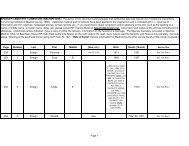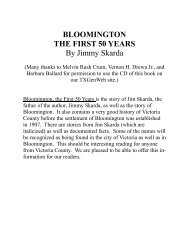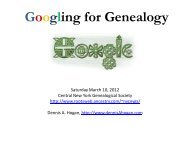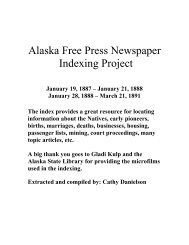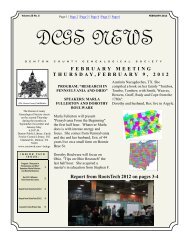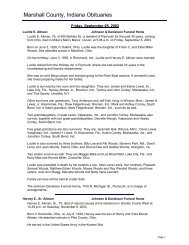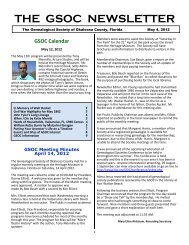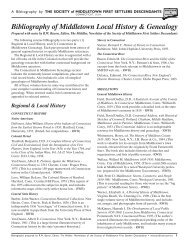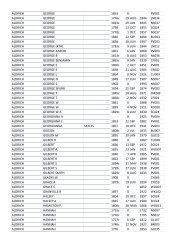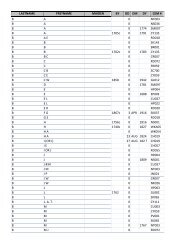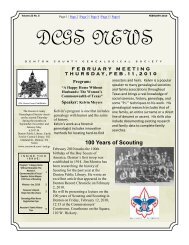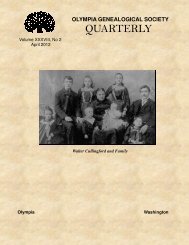Indian population in the United States and Alaska. 1910 - RootsWeb
Indian population in the United States and Alaska. 1910 - RootsWeb
Indian population in the United States and Alaska. 1910 - RootsWeb
Create successful ePaper yourself
Turn your PDF publications into a flip-book with our unique Google optimized e-Paper software.
STOCKS AND TRIBES, BY SEX, AGE, AND BLOOD. 107<br />
WAKASHAN STOCK.<br />
Stock as a whole.—^A stock whose ma<strong>in</strong> area of dis-<br />
tribution lies outside <strong>the</strong> <strong>United</strong> <strong>States</strong>, <strong>in</strong> British<br />
Columbia, ma<strong>in</strong>ly <strong>in</strong> Vancouver Isl<strong>and</strong> <strong>and</strong> <strong>the</strong> adjacent<br />
ma<strong>in</strong>l<strong>and</strong> coast as far north &i 54 degrees north<br />
latitude.<br />
The <strong>Indian</strong>s of <strong>the</strong> Wakashan stock <strong>in</strong> <strong>the</strong> <strong>United</strong><br />
<strong>States</strong>, as enumerated <strong>in</strong> <strong>1910</strong>, numbered 388. The<br />
tribes of this stock, for which members were reported,<br />
are as follows<br />
:<br />
Kitamat. Makah.<br />
•<br />
KwaMutl.<br />
Nootka.<br />
Kitamat—A tribe closely related to <strong>the</strong> Kwakiutl,<br />
liv<strong>in</strong>g on Douglas Channel, British Columbia. One<br />
white haK-breed woman, belong<strong>in</strong>g to this tribe, was<br />
enumerated <strong>in</strong> Wash<strong>in</strong>gton <strong>in</strong> <strong>1910</strong>.<br />
Kwakiutl.—A tribe occupy<strong>in</strong>g <strong>the</strong> ^<br />
nor<strong>the</strong>astern portion<br />
of Vancouver Isl<strong>and</strong>. One male, a mixed<br />
Kwakiutl-Lummi, was reported from Wash<strong>in</strong>gton <strong>in</strong><br />
<strong>1910</strong>.<br />
Makah.—The only tribe of this stock liv<strong>in</strong>g with<strong>in</strong><br />
<strong>the</strong> <strong>United</strong> <strong>States</strong>, <strong>the</strong> o<strong>the</strong>r members occupy<strong>in</strong>g parts<br />
of Vancouver Isl<strong>and</strong> <strong>and</strong> <strong>the</strong> adjacent coast of British<br />
Columbia.<br />
The Makah have lived, s<strong>in</strong>ce known to Europeans<br />
at <strong>the</strong> end of <strong>the</strong> eighteenth century, <strong>in</strong> <strong>the</strong> vic<strong>in</strong>ity of<br />
Cape Flattery, Wash., where a reservation was estab-<br />
lished for <strong>the</strong>m <strong>in</strong> 1855.<br />
The number enumerated <strong>in</strong> <strong>1910</strong> was 360, of which<br />
354 were <strong>in</strong> Wash<strong>in</strong>gton <strong>and</strong> 6 <strong>in</strong> Oregon. From <strong>the</strong><br />
follow<strong>in</strong>g figures, taken from <strong>the</strong> reports of <strong>the</strong> Commissioner<br />
of <strong>Indian</strong> Affairs, it. is seen that <strong>the</strong> general<br />
course of <strong>the</strong> <strong>population</strong> of this tribe <strong>in</strong> Wash<strong>in</strong>gton<br />
was slightly downward from 1870 to 1900, after which<br />
<strong>the</strong>re was an <strong>in</strong>crease. The high figures for 1865 <strong>and</strong><br />
1880 must have been due to errors of some sort.<br />
TEAR.



